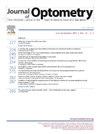Corneal higher-order aberrations in different types of irregular cornea
IF 1.8
Q2 OPHTHALMOLOGY
引用次数: 0
Abstract
Objetive
To assess differences in corneal higher-order aberrations (i.e., HOAs) between six different types of irregular corneas (i.e, keratoconus (KC), keratoglobus (KG), pellucid marginal degeneration (PMD), laser-assisted in situ keratomileusis (LASIK), penetrating keratoplasty (PK), and intrastromal corneal ring segments (ICRS)).
Methods
Corneal aberration data from the 3rd and 4th order together with secondary vertical and horizontal coma, and secondary spherical aberration were retrospectively retrieved from a corneal tomographer and compared between irregular cornea types and for 3-, 5-, and 7-mm pupil diameters.
Results
Significant differences were observed in vertical coma, oblique trefoil, secondary oblique astigmatism, primary spherical, and secondary spherical between irregular cornea types across all three pupil sizes (all p≤0.025). Vertical coma consistently exhibited the greatest magnitude of HOA across all irregular cornea types and pupil diameters. For the larger pupil diameters (5 and 7 mm), the 3rd order aberrations (mainly coma-like), the 4th order aberrations (mainly spherical-like), and total HOA RMS were significantly lower in the LASIK group compared to all other irregular cornea types (all p≤0.003). Additionally, at pupil sizes of 5 and 7 mm, the 3rd, 4th, coma-like, spherical-like, and total HOA RMS were significantly lower in KC compared to the ICRS and PK groups (all p≤0.01). Furthermore, the 4th, spherical-like, and total HOA RMS were significantly lower in KC compared to KG at pupil diameters of 3 and 7 mm, 5 and 7 mm, and 7 mm, respectively (all p≤0.03).
Conclusions
Vertical coma was the most elevated HOA across all irregular cornea types and pupil diameters. Corneal aberrations were lower in LASIK and KC, and higher in KG and PK.
不同类型不规则角膜的角膜高阶像差
目标评估六种不同类型的不规则角膜(即角膜屈光不正(KC)、角膜球体(KG)、透明边缘变性(PMD)、激光治疗角膜病变)之间角膜高阶像差(即HOA)之间的差异。六种不同类型的不规则角膜(即角膜炎(KC)、角膜浑浊(KG)、透明边缘变性(PMD)、激光辅助原位角膜磨镶术(LASIK)、穿透性角膜成形术(PK)和基质内角膜环段(ICRS))。方法从角膜断层摄影机中回顾性地检索了第 3 阶和第 4 阶角膜像差数据,以及次级垂直和水平昏迷和次级球面像差数据,并对不同类型的不规则角膜以及 3 毫米、5 毫米和 7 毫米瞳孔直径的角膜像差进行了比较。在所有不规则角膜类型和瞳孔直径中,垂直彗星的 HOA 值最大。对于较大的瞳孔直径(5 毫米和 7 毫米),与所有其他不规则角膜类型相比,LASIK 组的三阶像差(主要是昏迷)、四阶像差(主要是球面像差)和总 HOA RMS 明显较低(所有 p 均小于 0.003)。此外,在瞳孔大小为 5 毫米和 7 毫米时,与 ICRS 组和 PK 组相比,KC 组的第 3、第 4、昏迷样、球面样和总 HOA RMS 都明显较低(均 p≤0.01)。此外,在瞳孔直径分别为 3 和 7 毫米、5 和 7 毫米以及 7 毫米时,KC 组的第 4 次、球面样和总 HOA RMS 明显低于 KG 组(均 p≤0.03)。LASIK和KC的角膜像差较低,而KG和PK的角膜像差较高。
本文章由计算机程序翻译,如有差异,请以英文原文为准。
求助全文
约1分钟内获得全文
求助全文

 求助内容:
求助内容: 应助结果提醒方式:
应助结果提醒方式:


